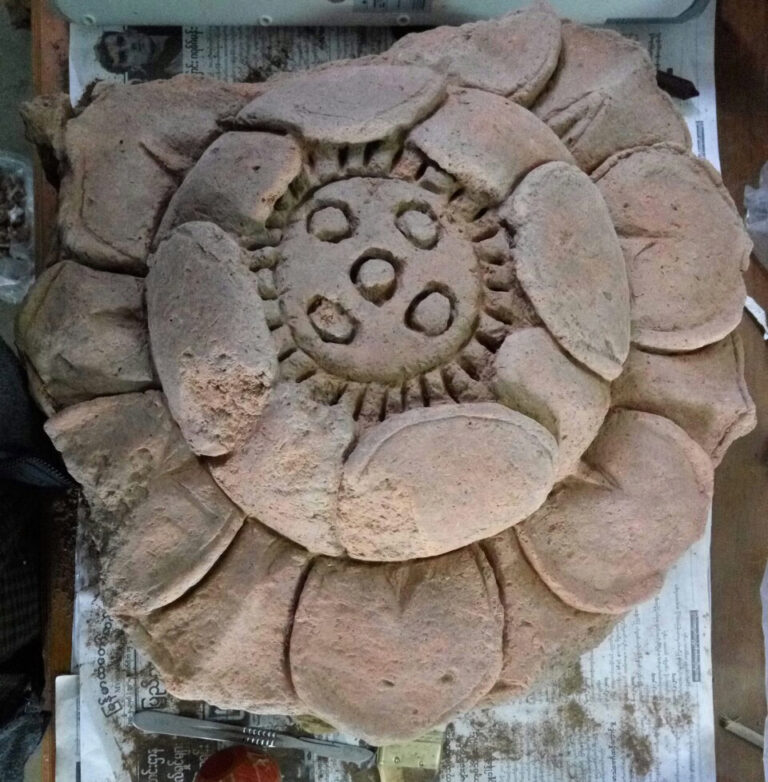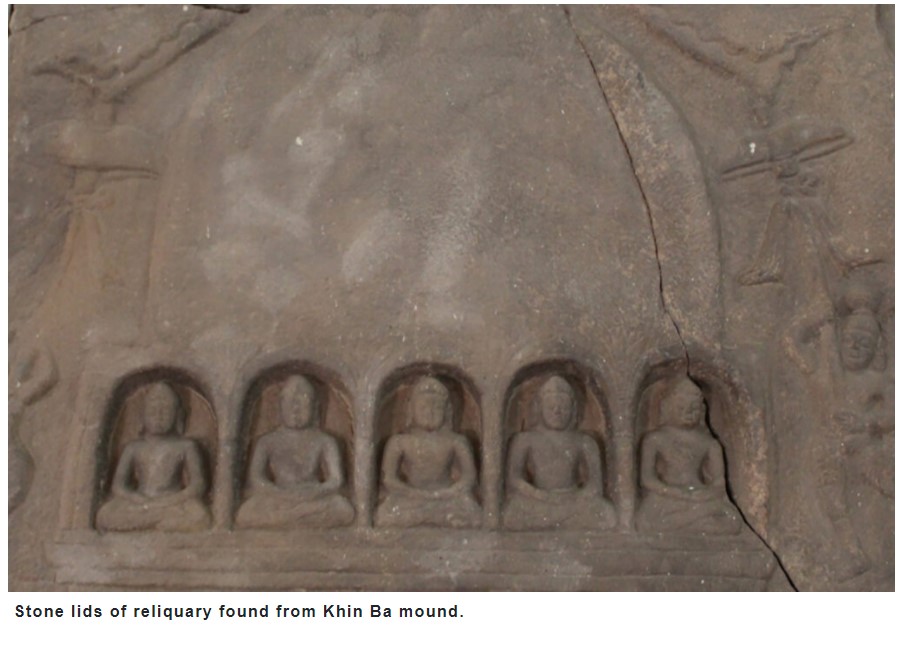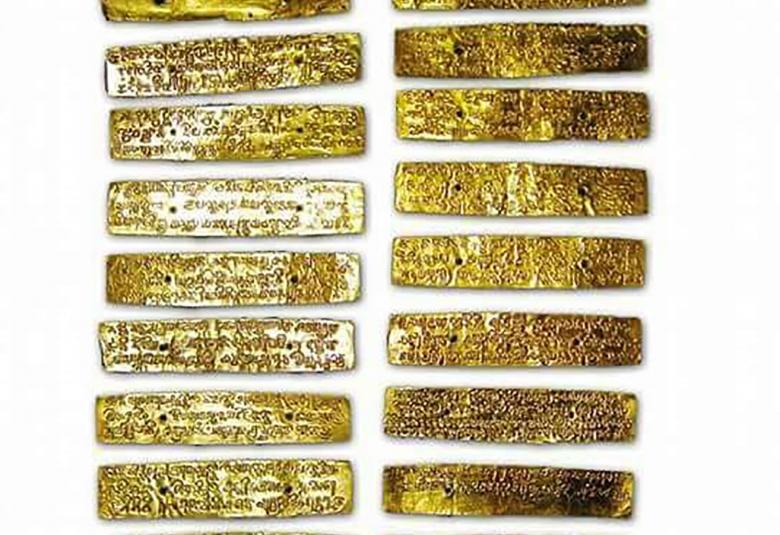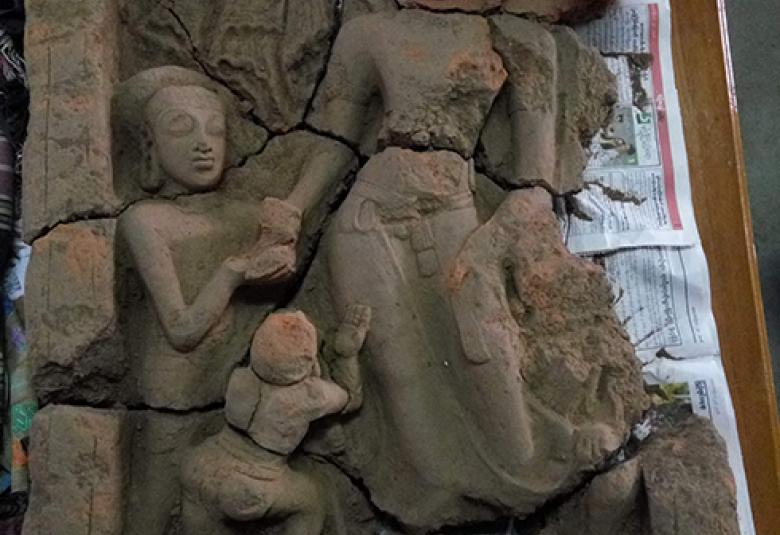December 19, 2020
By Maung Tha
(Archaeology)
(Translated by Than Tun Aung)
Sri Kestra, the largest in three ancient Pyu cities recognized as the world heritage sites by UNESCO in Myanmar, is five miles east of Pyay in Bago Region. It is located at 18° 75’ north latitude and 95° 25’ east longitude.
There remain many stupas and temples with trails of evidence in Pyu era including Khin Ba and Matheekya mounds in ancient Sri Kestra city.
Khin Ba mound
Khin Ba mound takes a position near Thayawady Gate in the southeast of the royal palace area in ancient Sri Kestra city, about 200 feet southwest of Kalakan Village. Title of the mound was based on owner of the area U Khin Ba.
Superintendent of archaeological survey Mr. Duroiselle and party excavated a cubic shape reliquary on Khin Ba mound in 1926 and found more than 500 ancient objects in 68 items including 20 gold palm-leaves. Among them, two stone lids in good condition of reliquary, a stone plaque in three pieces, a round silver casket in the shape of Bawdi throne and gold, silver and bronze Buddha images. Some of them were displayed at Thiri Khittaya museum in Sri Kestra.
Works of pagoda and Buddha reliefs on the lids were different from each other. The first stone lid bore bodies of five slim and soft Buddha images. The second one featured the chubby Buddha images.
The first stone lid was originally used in construction of the building on Khin Ba Mound. The second one might be used in renovation between 6th and 7th centuries, U Kyaw Myo Win, Deputy Director of Sri Kestra Section from Department of Archaeology and National Museum, reviewed.
After reconstructing the building of Khin Ba mound, religious objects were enshrined. The relief on the first stone lid was that of original pagoda, and another relief on the second lid shaped the renovated pagoda. The two can be seen at Thiri Khittaya museum.
The Department of Archaeology excavated Khin Ba mound in 1964 for conducting research. In the 2011-12 fiscal year, the department cooperated with Lerici Foundation from Italy in maintenance of Khin Ba mound, carrying out detail recording. In the 2015-16 fiscal year, further excavation was undertaken on Khin Ba mound where new trails evidences in Pyu era were found.

20 gold palm leaves
A total of 20 gold palm leaves found from the reliquary of building on Khin Ba mound were 6.5 inches long and 1.25 inches wide each. These layers were covered by one gold leave in same size on either side and bound by gold string. 22 gold leaves weighed 23 ticals, 14 pe and two yway in total.
Excerpts from Tri Pitakat treatises were expressed on gold palm leaves in the Pyu Language. The inscriptions found on ancient objects taken from Sri Kestra could be roughly divided into Pyu language and Pitakat literature. Pitakat literature was excerpts from Tri Pitakat treatises such as Suttanta, Vinaya and Abhidhamma preached by the Lord Buddha. Pyu literature was the literature carved in Pyu language, said U Sein Maung Oo, who excavated ancient Sri Kestra city.
Scholars conducted researches on gold palm leaves. U Lu Pe Win wrote the research paper on gold palm leaves from Khin Ba mound in the Myanmar Archaeological Research Report (1938-1939). Director of Culture Department U Tha Myat conducted the research in 1963 and Professor Daw Than Swe of Myanmar Language published the book on photos of Pyu language on gold palm leaves from Khin Ba mound and the book on studies in the Pyu Language on Khin Ba’s gold palm leaves in 1991.
The first to the 18th gold palm leaves bore three lines of inscriptions, the 19th gold palm leave four lines and the 20th, two lines, totalling 60.
U Sein Maung Oo remarked that the manuscripts on the gold palm leaves were similar to ancient Telagu Kanati alphabets used in southern India while Thiri Pyanchi U Mya expressed his reviews in the paper on the ancient Myanmar alphabets, saying that these gold palm leaves might be used between the 4th and 5th centuries.
The record posted in Khin Ba mound stated that the alphabets written on gold palm leaves were Pyu alphabets derived from Bramahi alphabet used by Ishawaku dynasty of southern India.
Silver Bawdi throne-shaped casket
The Bawdi throne shaped hollow silver casket, 72.5 centimetres high, found from Khin Ba mound, was made of four sitting Buddha images embossed on the lotus thrones around the Bo tree. Scholars assumed such silver casket was slightly later than gold palm leaves. The Buddha images were in Bhumi Phassa Mudra, and each disciple monk was in shape of standing among two Buddha images.
Titles of four already enlightened Buddha images were impressed on the brim of the upper lid and names of disciples and donor names on the lower brim.
Two remaining attributes of the Lord Buddha were written behind Gotama Buddha title on the casket. So, gold palm leaves and silver Bawdi casket found from Khin Ba mound were evidences of Pyu ethnics in their faith of Buddhism.
The seminar of scholars which took place at the Cambridge University of England in 1995 accepted gold palm leaves from Khin Ba mound as the works in early 5th century AD or mid-5th century AD. So, these objects became the most ancient among the evidences of Pali literature found across the world.
Professor Daw Than Swe reviewed “Gold palm leaves from Khin Ba mound express in-depth knowledge of Pyu people from the 5th century in religious affairs and wonderful arrangements”. As Pali alphabets on gold palm leaves were excerpts from Tri Pitakat treatises such as Suttanta, Vinaya and Abhidhamma, it was assumed that Pyu people thoroughly knew Pitakat literature. It proved that Theravada Pitakat treatises had been in Myanmar since flourishment of Pyu culture before Bagan era.
In 1897, Superintendent of stone inscription Dr E. Mil Forchhammer found two gold palm leaves on which excerpts from Pitakat literature were expressed in ancient alphabets similar to that of gold palm leaves from Khin Ba mound, from Maungkan mound near Lepaw Village in ancient Sri Kestra city, and these were called Maungkan gold palm leaves.
Maungkan gold palm leaves bore three lines each of inscriptions, both of which were expressed with excerpts of Pali literature starting from “Yedhamma Hetuppabhava”. Scholars estimated these inscriptions might be written in the 5th century. The alphabets on Maungkan gold palm leaves were similar to that of Khin Ba mound gold palm leaves.
It can be reviewed that Pyu people believed in Theravada Buddhism as Yedhamma Hetuppabhava Gatha which was summary of the Desana of Lord Buddha was preached by Shin Assaji to Upatissa which would be Shin Sariputtara in the future.
Maung Kyaw Nyein from Kyuntawsu Village found a gold palm leave bearing excerpts of Pitakat treatises in Sri Kestra in 1928. Attributes of the Lord Buddha such as Itipiso Bhagava was impressed on the palm leave. But, the palm leave was broken into pieces with losing the right top part. Alphabets on the palm leave were not beautiful and neat.
Baked earthen relief on Khin Ba mound
Engineering staff from Sri Kestra section found a broken baked earthen relief in the shape of woman head with beautiful face in Khin Ba mound in 2015. Such relief was cleansed by experts from Italy. Afterwards, a ray circle around the head and headdress, crown and decorated frontlet on forehead were clearly found. A place of the single strand of hair between two eyebrows was found on the face but it was not clear what kind of image was indicated.
In carrying out excavation on Khin Ba mound starting from 11 October 2016, broken pieces of baked earthen reliefs were found from the southern brick walls. In connecting with the previous head relief, a good relief emerged. The relief was 1.75 feet long and 2 feet and 10 inches wide.
The standing woman of relief did not have developed breasts but her both arms were worn with braces. The relief was worn with girdle with fringe. Right hand of the relief was in shape of giving something to a person with shut eyes while a child from the relief was stretching its hand to demand something. The relief’s ears did not touch the shoulders, so it was assumed the relief was made in Pyu era.
A baked earthen lotus flower in circular shape was excavated from Khin Ba mound. Similar object of silverware was also unearthed in excavation of Khin Ba mound in 1926. Both objects were the same.
The evidence was found on Khin Ba mound where objects and reliefs created in religions were enshrined in the religious edifices in line with OUV No 2 set as world heritage sites.
However, 20 gold palm leaves bearing excerpts of Buddhist literature and excerpts from Pitakat treatises proved flourishing of Theravada Buddhism in Sri Kestra.
As such, Sri Kestra and Khin Ba mound where a great deal of cultural evidence of Pyu people were found catch attentions of scholars and researchers.
References:
Studies on Pyu literature from Khin Ba mound (Daw Than Swe)
Pyu reader (U Tha Myat)
Findings on faith of Buddhism in Myanmar on Khin Ba mound before Bagan era (U Kyaw Myo Win)




